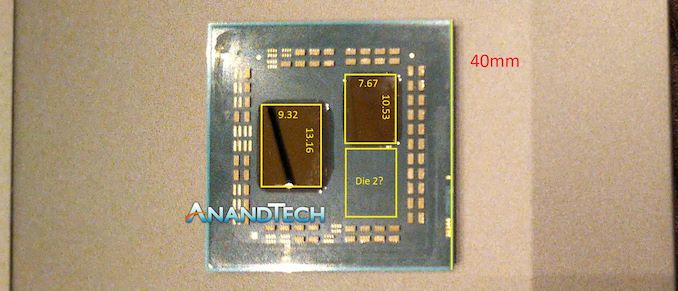AMD: “No Chiplet APU Variant on Matisse, CPU TDP Range same as Ryzen-2000”
by Ian Cutress on January 11, 2019 12:30 PM EST- Posted in
- CPUs
- AMD
- Trade Shows
- Zen 2
- CES 2019
- Ryzen 3rd Gen
- Matisse

One of the big questions coming out of AMD’s CES announcements was if its new CPU design, codenamed Matisse and which enables two chiplets and an IO die on a single package, would support one of those chiplets being graphics based in order to make an APU. In our discussions with AMD, we received confirmation that this will not be the case.
The new Matisse design is the platform for AMD’s next generation of desktop processors. The layout shown at CES this year represented the design as having a single IO die, about 122.6 mm2 and built on GlobalFoundries 14nm, paired with a chiplet die, about 80.8 mm2, containing eight cores and built on TSMC’s 7nm. There is obviously space on that package for another CPU chiplet, and there has always been questions if the chiplet design is amenable to using a graphics chiplet instead.
AMD stated that, at this time, there will be no version of the current Matisse chiplet layout where one of those chiplets will be graphics. We were told that there will be Zen 2 processors with integrated graphics, presumably coming out much later after the desktop processors, but built in a different design. Ultimately APUs are both mobile first as well as lower cost parts (usually), so different design decisions will have to be made in order to support that market.
This doesn't rule out a future processor using chiplet graphics, this is just for Matisse.
Our contacts at AMD also discussed the TDP range of the upcoming range of Matisse processors. Given AMD’s definition of TDP, relating to the cooling performance required of the CPU cooler, the range of TDPs for Matisse will be the same as current Ryzen 2000-series processors. This means we could see ‘E’ variants as low as 35W TDP, all the way up to the top ‘X’ processors at 105W, similar to the current Ryzen 7 2700X. We were told that the company expects the processors will fit within that range. This should be expected on some level, given the backwards compatibility with current AM4 motherboards on the market with a BIOS update.
Read our announcement on the early preview of the Matisse processors here:
https://www.anandtech.com/show/13829/amd-ryzen-3rd-generation-zen-2-pcie-4-eight-core










52 Comments
View All Comments
yeeeeman - Friday, January 11, 2019 - link
It actually makes sense since current APUs have 4/8 core/threads configurations in a single die. They can probably up that to 8/16 core/threads + some Vega/Navi (hopefully) cores and call it a day. You don't need/want more than 8 cores in an APU be it in laptop or in desktop config.Another thing to consider is the fact that chiplet design is good for yields and scalability, but it is a source of power waste and/or performance loss compared to a monolithic die.
pfdman - Friday, January 11, 2019 - link
They also need at least 6 cores in their laptop offerings in order to compete with Intel's 6 core laptop chips. So the next round of APUs after the 3000 series will have at least 8 cores. But since the 3000 series laptop APUs were just announced, we won't see 8 core chips in their laptops till next year.neblogai - Friday, January 11, 2019 - link
Next monolithic APU is Renoir/Grey Hawk: 7nm 4-core with Vega graphics, 10-35W TDP.Cooe - Friday, January 11, 2019 - link
The 4-cores & Vega graphics parts of that statement are nowhere even remotely close to being "confirmed facts". At this point, we know next time nothing about Renoir aside from the fact it'll be fabbed on 7nm & be a Picasso successor thanks to it's placement on leaked AMD product development time-tables. Nothing more beyond that information exists at this point; ESPECIALLY fine details like core count & GPU arch.neblogai - Friday, January 11, 2019 - link
https://www.reddit.com/r/hardware/comments/aemjgn/...nandnandnand - Saturday, January 12, 2019 - link
If they don't put 6-8 cores in a mobile APU, I'm not buying it. End of story. I'd wait another year.However, if they are using the 8-core chiplets across all product lines, I don't see why they would not have 8 cores for laptops on 7nm. Especially if they are going to double the max Ryzen desktop core count to 16.
darkswordsman17 - Friday, January 11, 2019 - link
I'm not sure this changes much as far as the prospect of them making APUs that use separate modules instead of monolithic die. The reason being that pairing a CPU and a decent sized GPU would be less than optimal for the AM4 platform. While it could still be decent and well built boards could support it. I would think this type of APU would skip a socket for now (or require something like the TR4 socket). This way there's less limitations on power and memory setup, and they'd likely be custom built for the customers (for instance console companies). That would make more sense for laptops as well (although I don't really expect such a product, it'd be nice to see). And All-in-One systems would probably be better off with dGPU on a card, and SFF - like Mac Mini type - would be better with an eGPU box.BigMamaInHouse - Saturday, January 12, 2019 - link
Can you Imaging 8 chiplet like this on TR3? I think over 15K on CB-R15 going to be easy (on stock or P.B.O), It's Crazy time Saver for Professionals!.dromoxen - Tuesday, January 15, 2019 - link
Corsair has already produced a module to be fitted to the space on the CPU.. it consists of a small capillex screen which can display any cpu or other system information, all in a breathing pattern.